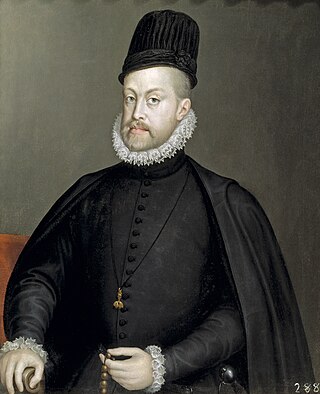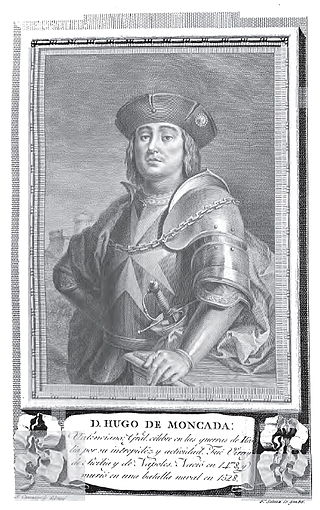Charles of Navarre or Charles d'Albret (12 December 1510, Pau - September 1528, Naples) was a prince of Navarre.
Charles of Navarre or Charles d'Albret (12 December 1510, Pau - September 1528, Naples) was a prince of Navarre.
born as a member of the Albret dynasty, reigning family of the Kingdom of Navarre, Charles was the youngest son of the Navarrese monarchs Catherine and her husband, John III. On their mother's death in 1517 Charles's elder brother Henry II inherited the crown. Navarre joined with the League of Cognac against Emperor Charles V and Charles of Navarre fought against the Imperial forces at Naples in 1528, where he was captured. He died the following year whilst still heir presumptive to the throne of Navarre - Henry II's first child, Joan, was only born in November 1528.

The House of Bourbon is a dynasty that originated in the Kingdom of France as a branch of the Capetian dynasty, the royal House of France. Bourbon kings first ruled France and Navarre in the 16th century. A branch descended from the French Bourbons came to rule Spain in the 18th century and is the current Spanish royal family. Further branches, descended from the Spanish Bourbons, held thrones in Naples, Sicily, and Parma. Today, Spain and Luxembourg have monarchs of the House of Bourbon. The royal Bourbons originated in 1272, when Robert, the youngest son of King Louis IX of France, married the heiress of the lordship of Bourbon. The house continued for three centuries as a cadet branch, serving as nobles under the direct Capetian and Valois kings.

Philip II, also known as Philip the Prudent, was King of Spain from 1556, King of Portugal from 1580, and King of Naples and Sicily from 1554 until his death in 1598. He was also jure uxoris King of England and Ireland from his marriage to Queen Mary I in 1554 until her death in 1558. He was also Duke of Milan from 1540. From 1555, he was Lord of the Seventeen Provinces of the Netherlands.

The Capetian house of Valois was a cadet branch of the Capetian dynasty. They succeeded the House of Capet to the French throne, and were the royal house of France from 1328 to 1589. Junior members of the family founded cadet branches in Orléans, Anjou, Burgundy, and Alençon.

Charles IX was King of France from 1560 until his death in 1574. He ascended the French throne upon the death of his brother Francis II in 1560, and as such was the penultimate monarch of the House of Valois.

Henry II, nicknamed Sangüesino because he was born at Sangüesa, was the King of Navarre from 1517, although his kingdom had been reduced to a small territory north of the Pyrenees by the Spanish conquest of 1512. Henry succeeded his mother, Queen Catherine, upon her death. His father was her husband and co-ruler, King John III, who died in 1516.

Antoine de Bourbon, roi de Navarre was the King of Navarre through his marriage to Queen Jeanne III, from 1555 until his death. He was the first monarch of the House of Bourbon, of which he was head from 1537. Despite being first prince of the blood, Antoine lacked political influence and was dominated by king Henry II's favourites, the Montmorency and Guise families. When Henri died in 1559, Antoine found himself sidelined in the Guise-dominated government, and then compromised by his brother's treason. When Francis in turn died he returned to the centre of politics, becoming Lieutenant-General of France and leading the army of the crown in the first of the French Wars of Religion. He died of wounds sustained during the Siege of Rouen. He was the father of Henry IV of France.
Joan of Navarre may refer to:

Charles, Prince of Viana, sometimes called Charles IV of Navarre, was the son of King John II of Aragon and Queen Blanche I of Navarre.
Count of Guise and Duke of Guise were titles in the French nobility.

This is a list of the Lords, Barons and Marquisses of Baux.

John III was jure uxoris King of Navarre from 1484 until his death, as husband and co-ruler of Queen Catherine.

Catherine was Queen of Navarre from 1483 until 1517. She was also Duchess of Gandia, Montblanc, and Peñafiel, Countess of Foix, Bigorre, and Ribagorza, and Viscountess of Béarn.

Juana Enriquez, 5th Lady of Casarrubios del Monte was Queen of Aragon and de facto Queen consort of Navarre as the wife of King John II. Juana Enríquez was the Regent of Navarre during the absence of her husband in the Navarrese Civil War (1451–1455); she also served as Governor of Catalonia in 1462 in the place of her son and, finally, as Regent of Aragon during the absence of her husband in the Catalan Civil War between 1465 and 1468.

Hugo de Moncada a.k.a. Ugo de Moncada, was a Spanish political and military leader of the late 15th and early 16th century. He served as General of Ocean and Land, Viceroy of Sicily, 1509–1517, Viceroy of Naples, 1527 - 1528.

Catherine of Bourbon was a Navarrese princess regent. She was the daughter of Queen Jeanne d'Albret and King Antoine of Navarre. She ruled the principality of Béarn in the name of her brother, King Henry III of Navarre, from 1576 until 1596.

Françoise d'Alençon was the eldest daughter of René of Alençon and Margaret of Lorraine, and the younger sister and despoiled heiress of Charles IV, Duke of Alençon.

Ferdinand II was King of Aragon from 1479 until his death in 1516. As the husband and co-ruler of Queen Isabella I of Castile, he was also King of Castile from 1475 to 1504. He reigned jointly with Isabella over a dynastically unified Spain; together they are known as the Catholic Monarchs. Ferdinand is considered the de facto first king of Spain, and was described as such during his reign, even though, legally, Castile and Aragon remained two separate kingdoms until they were formally united by the Nueva Planta decrees issued between 1707 and 1716.
The Catalan Civil War, also called the Catalonian Civil War or the War against John II, was a civil war in the Principality of Catalonia, then part of the Crown of Aragon, between 1462 and 1472. The two factions, the royalists who supported John II of Aragon and the Catalan constitutionalists, disputed the extent of royal rights in Catalonia. The French entered the war at times on the side on John II and at times with the Catalans. The Catalans, who at first rallied around John's son Charles of Viana, set up several pretenders in opposition to John during the course of the conflict. Barcelona remained their stronghold to the end: with its surrender the war came to a close. John, victorious, re-established the status quo ante bellum.

Jeanne d'Albret, also known as Jeanne III, was Queen of Navarre from 1555 to 1572.